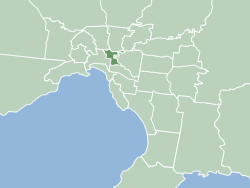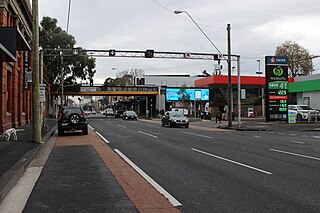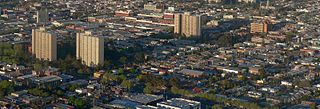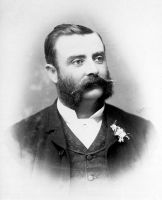
The Yarra River or historically, the Yarra Yarra River, is a perennial river in south-central Victoria, Australia.

The City of Yarra is a local government area (LGA) in Victoria, Australia in the inner eastern and northern suburbs of Melbourne. It is the second smallest LGA in the state with an area of 19.5 square kilometres (7.5 sq mi), and in June 2021 it had a population of 91,543, making it the second most densely populated LGA, with around 4,695 people per square kilometre. The City of Yarra was formed in 1994 as a result of the amalgamation of the former Cities of Richmond, Collingwood, Fitzroy, and parts of Carlton North and parts of Alphington and Fairfield.

Port Melbourne is an inner-city suburb in Melbourne, Victoria, Australia, 3 km (2 mi) south-west of the Melbourne central business district, located within the Cities of Melbourne and Port Phillip local government areas. Port Melbourne recorded a population of 17,633 at the 2021 census.

Abbotsford is an inner-city suburb in Melbourne, Victoria, Australia, 2 km (1.2 mi) north-east of Melbourne's Central Business District, located within the City of Yarra local government area. Abbotsford recorded a population of 9,088 at the 2021 census.

Burnley is an inner-city suburb in Melbourne, Victoria, Australia, 4 km east of the Melbourne central business district, located within the City of Yarra local government area. Burnley recorded a population of 794 at the 2021 census.

Collingwood is an inner-city suburb in Melbourne, Victoria, Australia, 3km north-east of the Melbourne central business district, located within the City of Yarra local government area. Collingwood recorded a population of 9,179 at the 2021 census.

Fitzroy is an inner-city suburb in Melbourne, Victoria, Australia, 3 km (1.9 mi) north-east of Melbourne's Central Business District, located within the City of Yarra local government area. Fitzroy recorded a population of 10,431 at the 2021 census.

Alphington is a suburb in Melbourne, Victoria, Australia, 7 km (4.3 mi) north-east of Melbourne's Central Business District, located within the Cities of Darebin and Yarra local government areas. Alphington recorded a population of 5,702 at the 2021 census.

Collingwood Children's Farm is a not-for-profit, inner city working farm situated on the Yarra River in the Melbourne suburb of Abbotsford, Australia. It is located within Wurundjeri/Woiwurrung country. It is adjacent to the Abbotsford Convent, and considered part of the larger Abbotsford Heritage Precinct Farmlands (APHF). The APHF supporting the Collingwood Children's Farm are unique in being the oldest continually farmed land in the state of Victoria. European farming commenced in early 1836, with formal land sales occurring in 1838. Farming on the APHF has continued uninterrupted from its agricultural use by Wurundjeri/Woiwurrung to grow crops such as Murnong. It is also the oldest children's farm in Australia, established in 1979.

The Capital City Trail is a shared use path in Melbourne, Victoria, Australia, which circles the city centre and some inner eastern and northern suburbs. It is 29km in length, and mostly consists of sections of other trails, such as the Merri Creek Trail, Main Yarra Trail, Moonee Ponds Creek Trail and Inner Circle Rail Trail.

William Pitt was an Australian architect and politician. Pitt is best known as one of the outstanding architects of the "boom" era of the 1880s in Melbourne, designing some of the city's most elaborate High Victorian commercial buildings. He worked in a range of styles including Gothic Revival, Italianate, French Second Empire, and his own inventive eclectic compositions. He had a notable second career after the crash of the 1890s, becoming a specialist in theatres and industrial buildings.

Victoria Street is one of the major thoroughfares of inner Melbourne, running east–west for over six kilometres between Munster Terrace in North Melbourne and the Yarra River. The road is known as Victoria Parade for over one-and-a-half kilometres of its length, distinguishable with a wide reservation and tramway down the middle.

The Congregation of Our Lady of Charity of the Good Shepherd, also known as the Sisters of the Good Shepherd, is a Catholic religious order that was founded in 1835 by Mary Euphrasia Pelletier in Angers, France. The religious sisters belong to a Catholic international congregation of religious women dedicated to promoting the welfare of women and girls.

Sophia Mundi Steiner School is a private school located in Abbotsford, Victoria, Australia, that follows Rudolf Steiner's educational philosophy. Schools which follow Rudolf Steiner's theories are known as Steiner schools, or Waldorf schools. Sophia Mundi was founded in 1985 by a group of parents. Classes Prep to Year 12 are based in the St. Mary's building of the Abbotsford Convent complex. A Playgroup is also offered on site.

The Main Yarra Trail, also known as the Yarra Trail is a shared-use path for cyclists and pedestrians, which follows the Yarra River through the northeastern suburbs of Melbourne, Victoria, Australia.

Sunbury Lunatic Asylum was a 19th-century mental health facility known as a lunatic asylum, located in Sunbury, Victoria, Australia, first opened in October 1879.

The Wurundjeri Woi Wurrung Cultural Heritage Aboriginal Corporation, previously the Wurundjeri Tribe Land and Compensation Cultural Heritage Council, is a Registered Aboriginal Party representing the Wurundjeri people, an Aboriginal Australian people of Victoria.

Mount Saint Canice was a Roman Catholic former convent that was located in Sandy Bay, Hobart, Tasmania, Australia and run by the Congregation of Our Lady of Charity of the Good Shepherd, commonly called the Sisters of the Good Shepherd, from 1893 to 1974.

Johnston Street Bridge is a concrete road bridge crossing the Yarra River between the Melbourne suburbs of Abbotsford and Kew.

Mary of St. Joseph Doyle was an Australian religious sister, and the first Prioress of the Abbotsford Convent, in Melbourne, Australia.

























